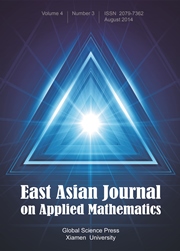Crossref Citations
This article has been cited by the following publications. This list is generated based on data provided by
Crossref.
Khan, Najeeb Alam
Hameed, Tooba
and
Ahmed, Samreen
2019.
Homotopy perturbation aided optimization procedure with applications to oscillatory fractional order nonlinear dynamical systems.
International Journal of Modeling, Simulation, and Scientific Computing,
Vol. 10,
Issue. 04,
p.
1950026.
Chen, Hu
Hu, Xiaohan
Ren, Jincheng
Sun, Tao
and
Tang, Yifa
2019.
L1 scheme on graded mesh for the linearized time fractional KdV equation with initial singularity.
International Journal of Modeling, Simulation, and Scientific Computing,
Vol. 10,
Issue. 01,
p.
1941006.
Li, Dongfang
Wu, Chengda
and
Zhang, Zhimin
2019.
Linearized Galerkin FEMs for Nonlinear Time Fractional Parabolic Problems with Non-smooth Solutions in Time Direction.
Journal of Scientific Computing,
Vol. 80,
Issue. 1,
p.
403.
Arshad, Sadia
Baleanu, Dumitru
Defterli, Ozlem
and
Shumaila
2019.
A numerical framework for the approximate solution of fractional tumor-obesity model.
International Journal of Modeling, Simulation, and Scientific Computing,
Vol. 10,
Issue. 01,
p.
1941008.
Jian, Huanyan
Huang, Tingzhu
Zhao, Xile
and
Zhao, Yongliang
2019.
FAST SECOND-ORDER ACCURATE DIFFERENCE SCHEMES FOR TIME DISTRIBUTED-ORDER AND RIESZ SPACE FRACTIONAL DIFFUSION EQUATIONS.
Journal of Applied Analysis & Computation,
Vol. 9,
Issue. 4,
p.
1359.
Wei, Yabing
Zhao, Yanmin
Wang, Fenling
Tang, Yifa
and
Yang, Jiye
2020.
Superconvergence Analysis of Anisotropic FEMs for Time Fractional Variable Coefficient Diffusion Equations.
Bulletin of the Malaysian Mathematical Sciences Society,
Vol. 43,
Issue. 6,
p.
4411.
An, Na
2020.
Superconvergence of a finite element method for the time-fractional diffusion equation with a time-space dependent diffusivity.
Advances in Difference Equations,
Vol. 2020,
Issue. 1,
Zhu, Ailing
Wang, Yixin
and
Xu, Qiang
2020.
A weak Galerkin finite element approximation of two-dimensional sub-diffusion equation with time-fractional derivative.
AIMS Mathematics,
Vol. 5,
Issue. 5,
p.
4297.
Li, Hongwei
and
Wu, Yuchen
2021.
Artificial boundary conditions for nonlinear time fractional Burgers’ equation on unbounded domains.
Applied Mathematics Letters,
Vol. 120,
Issue. ,
p.
107277.
Wei, Yabing
Lü, Shujuan
Chen, Hu
Zhao, Yanmin
and
Wang, Fenling
2021.
Convergence analysis of the anisotropic FEM for 2D time fractional variable coefficient diffusion equations on graded meshes.
Applied Mathematics Letters,
Vol. 111,
Issue. ,
p.
106604.
Zhao, Daliang
and
Mao, Juan
2021.
Positive Solutions for a Class of Nonlinear Singular Fractional Differential Systems with Riemann–Stieltjes Coupled Integral Boundary Value Conditions.
Symmetry,
Vol. 13,
Issue. 1,
p.
107.
Zhao, Daliang
and
Liu, Yansheng
2021.
Controllability of nonlinear fractional evolution systems in Banach spaces: A survey.
Electronic Research Archive,
Vol. 29,
Issue. 5,
p.
3551.
Wu, Yuchen
and
Li, Hongwei
2022.
Efficient approach to solve time fractional Kardar–Parisi–Zhang equation on unbounded domains.
Applied Mathematics Letters,
Vol. 129,
Issue. ,
p.
107967.
Wei, Yabing
Lü, Shujuan
Wang, Fenling
Liu, F.
and
Zhao, Yanmin
2022.
Global superconvergence analysis of nonconforming finite element method for time fractional reaction-diffusion problem with anisotropic data.
Computers & Mathematics with Applications,
Vol. 119,
Issue. ,
p.
159.
Zhang, Hui
Zeng, Fanhai
Jiang, Xiaoyun
and
Karniadakis, George Em
2022.
Convergence analysis of the time-stepping numerical methods for time-fractional nonlinear subdiffusion equations.
Fractional Calculus and Applied Analysis,
Vol. 25,
Issue. 2,
p.
453.
Zhang, Hui
Zeng, Fanhai
Jiang, Xiaoyun
and
Zhang, Zhimin
2024.
Fast time-stepping discontinuous Galerkin method for the subdiffusion equation.
IMA Journal of Numerical Analysis,
Bu, Weiping
Xu, Xiaohong
and
Zhao, Yue
2025.
Efficient finite difference method for two-dimensional diffusion equation in comb structure with fractional derivative boundary conditions.
International Journal of Modeling, Simulation, and Scientific Computing,
Vol. 16,
Issue. 01,


